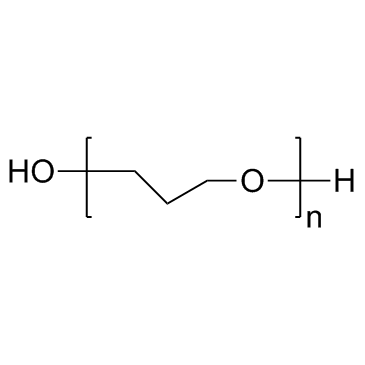PEG300 (Glycols polyethylene) |
| Katalog-Nr.GC30022 |
PEG-300, ein neutrales Polymer mit einem Molekulargewicht von 300, zeichnet sich durch Wasserlöslichkeit, geringe Immunogenität und Biokompatibilität aus, bestehend aus wiederholten Einheiten von Ethylenglykol.
Products are for research use only. Not for human use. We do not sell to patients.

Cas No.: 25322-68-3
Sample solution is provided at 25 µL, 10mM.
PEG-300, a neutral polymer with a molecular weight of 300, is a water-soluble, low immunogenic and biocompatible polymer formed by repeating units of ethylene glycol [1,2].
Relatively high but clinically achievable PEG-300 levels can inhibit P-gp activity in Caco-2 cell monolayers, thereby enhancing the permeability of anticancer drugs such as paclitaxel and doxorubicin. For example, increasing the concentration of PEG-300 will lead to the increase of Papp and AP to BL of [3H] paclitaxel [P-gp substrate][3-6]12-14,28 and the decrease of Papp and BL to AP. At high concentrations (20%, v/v) of peg-300, it seems that paclitaxel is transported across Caco-2 cell monolayers by simple passive transcellular diffusion. Similar peg induced inhibition of efflux transporters (e.g., P-gp and / or P-gp / MRP activity) was observed in Caco-2 cells, [5] doxorubicin, indicating that PEG induced inhibition of efflux is not a unique phenomenon of paclitaxel.
References:
[1] Lee C C, Su Y C, Ko T P, et al. Structural basis of polyethylene glycol recognition by antibody[J]. Journal of biomedical science, 2020, 27(1): 1-13.
[2] Billingham J, Breen C, Yarwood J. Adsorption of polyamine, polyacrylic acid and polyethylene glycol on montmorillonite: An in situ study using ATR-FTIR[J]. Vibrational Spectroscopy, 1997, 14(1): 19-34.
[3] Krishna R, Mayer L D. Multidrug resistance (MDR) in cancer: mechanisms, reversal using modulators of MDR and the role of MDR modulators in influencing the pharmacokinetics of anticancer drugs[J]. European Journal of Pharmaceutical Sciences, 2000, 11(4): 265-283.
[4] Van Asperen J, Van Tellingen O, Sparreboom A, et al. Enhanced oral bioavailability of paclitaxel in mice treated with the P-glycoprotein blocker SDZ PSC 833[J]. British Journal of Cancer, 1997, 76(9): 1181-1183.
[5] van Asperen J, van Tellingen O, van der Valk M A, et al. Enhanced oral absorption and decreased elimination of paclitaxel in mice cotreated with cyclosporin A[J]. Clinical cancer research: an official journal of the American Association for Cancer Research, 1998, 4(10): 2293-2297.
Average Rating: 5 (Based on Reviews and 31 reference(s) in Google Scholar.)
GLPBIO products are for RESEARCH USE ONLY. Please make sure your review or question is research based.
Required fields are marked with *




